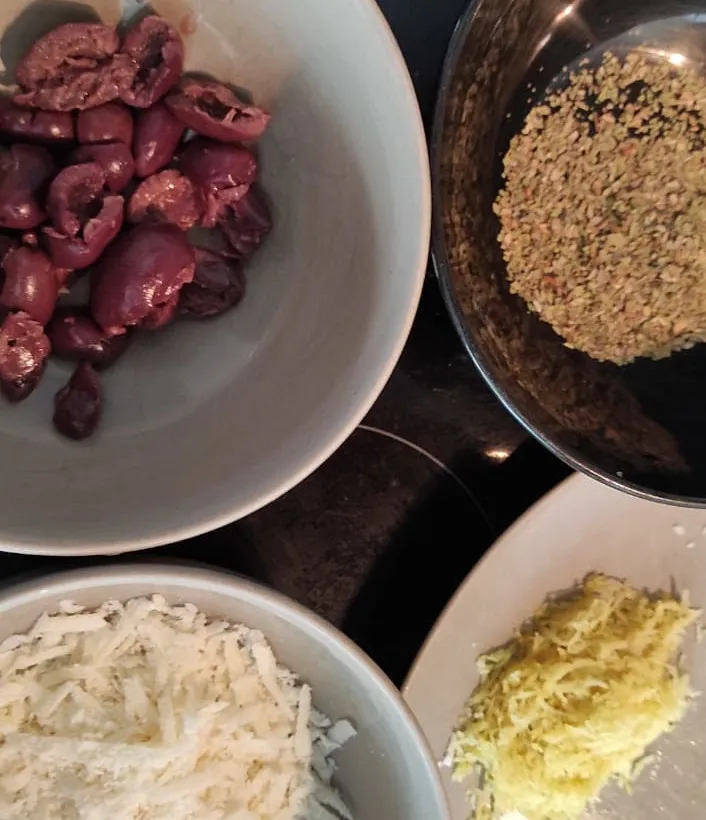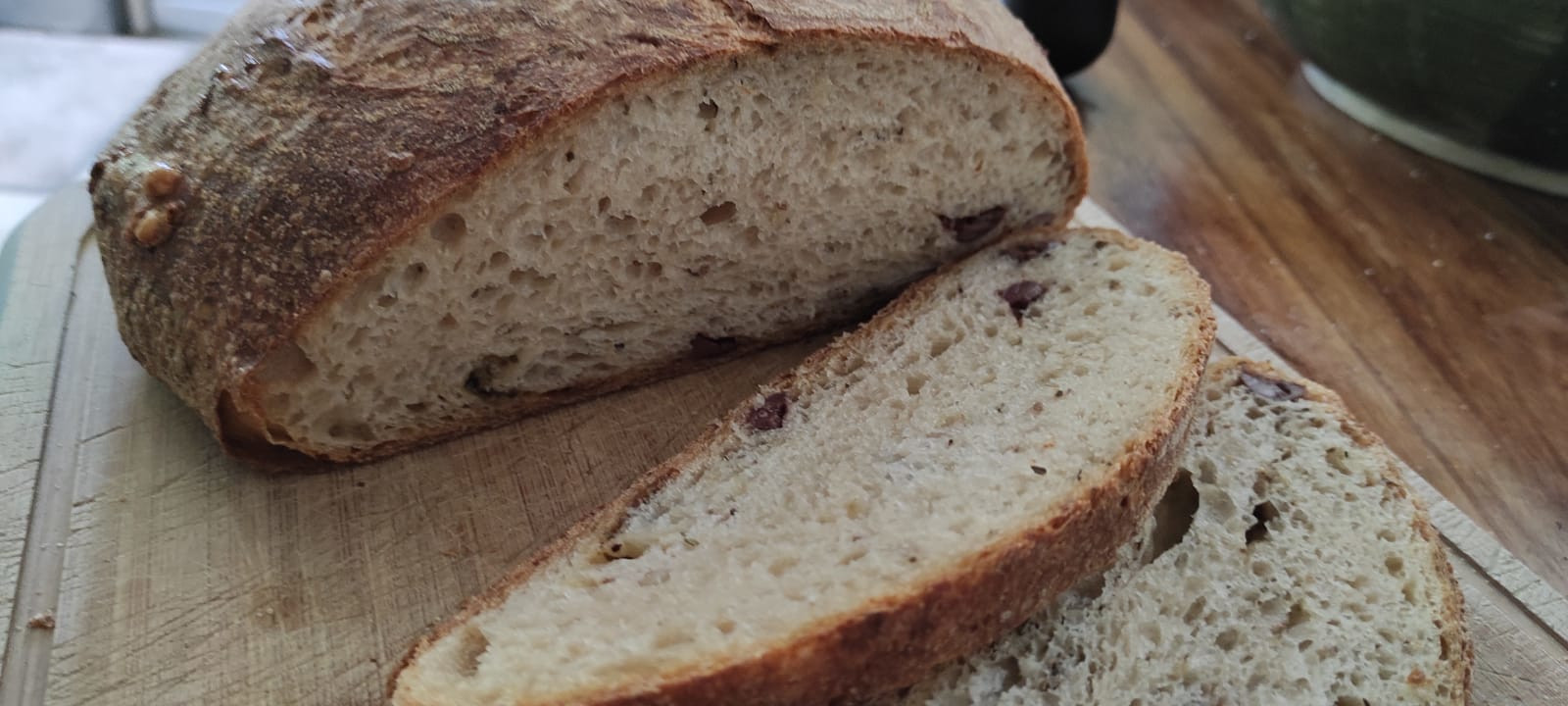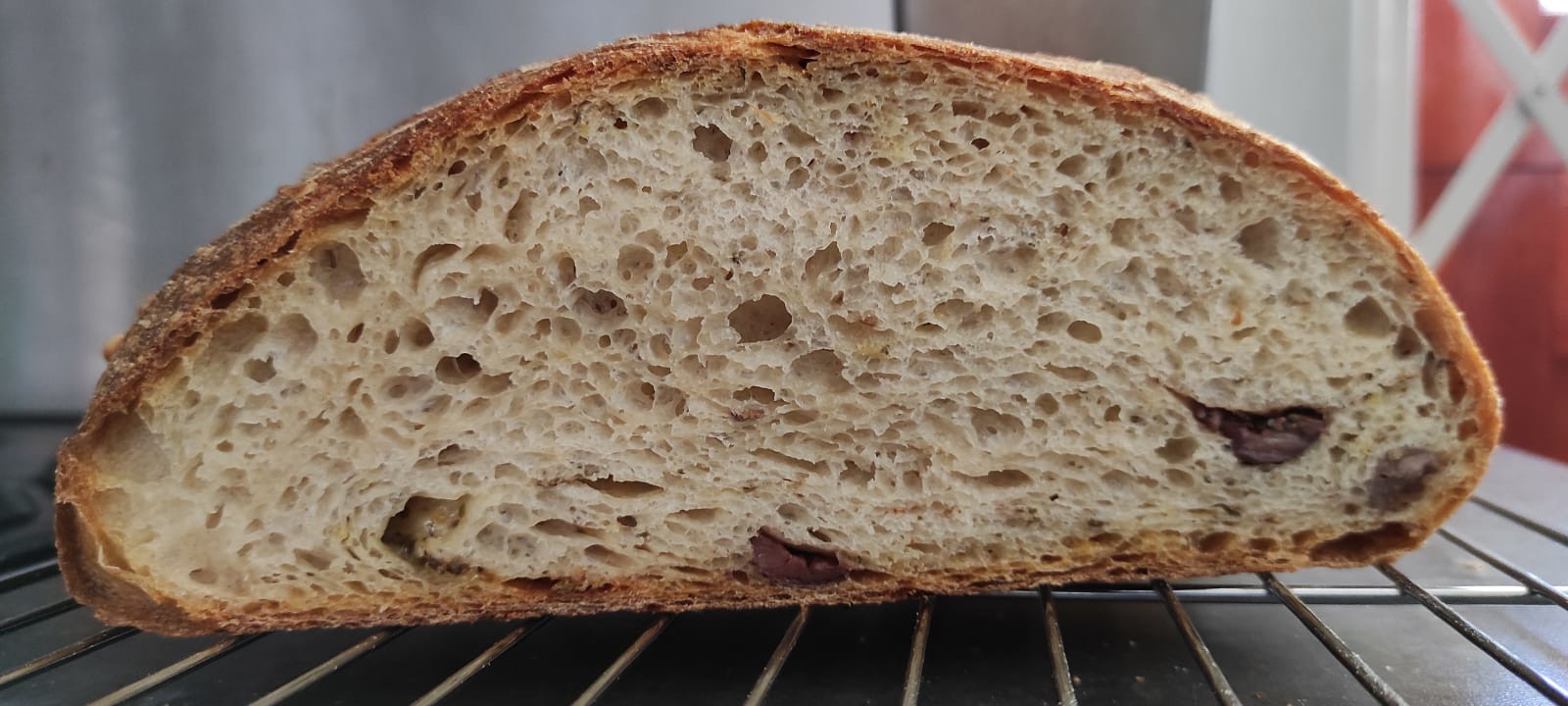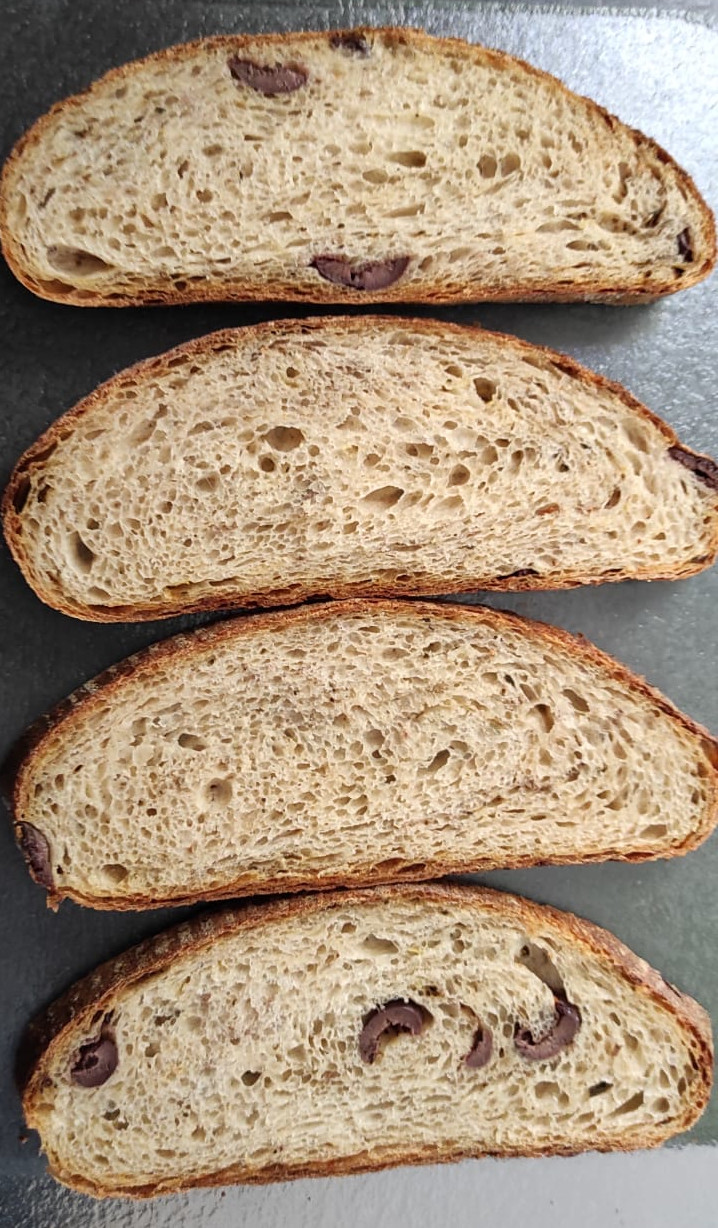
Gosh. Kicking myself that I hadn't tried out parmesan in my breads before. This bread had a great combination of inclusions: 41g of parmesan cheese, grated from a frozen block. Fresh zest of one lemon, about 3 tsp worth. 2 tsp of dried origanum (marjoram). And 45g of Kalamata olives (13 ea). Incredible smell when it was out of the oven. I couldn't wait the two hours for it to cool. Was cutting into it after 40 minutes, sometimes it is the guilty pleasure of hot steamy crusty bread that is the most enjoyable.
This bread is, once again, a raisin water yeast bread, and once again using the Hamelman recipe from the community bake as the base. For this one though I didn't have time to do a double build. So there was only a single build made using 153g active and fizzy raisin yeast water straight from the fridge, with 169g strong bread flour and 57g atta, other than that (and the different inclusions) it was faithful to the community bake recipe.
The build was used 9 hours later in the final dough, which was mixed all-in-one together with the salt. Had more trouble than usual getting the stand mixer to run 'clean' which is my normal guide to good gluten development. Previously, with the same flours I've done an all-in-one mix with this recipe and had good gluten development after about 8 minutes but this bread ended up getting a whopping 27 minutes of mix time (in 10 minute intervals with some rest between) before I was satisfied. Next time I will pay closer attention as to the order of adding items to the mix, and might do an autolyse or delay the addition of the salt (which is a great tool to tighten the gluten if the dough isn't developing satisfactorily). 27 minutes of mix time is not typical for me, but it certainly built a nice enough crumb!
A lamination was done shortly after the mix and all the inclusions were added in then. There was no opportunity for a coil fold, as bulk fermentation was in a proofer set to 27°C (80°F) and fermentation proceeded quickly. The dough was final shaped 2 hours after the initial mix, and then had an additional 1.5 hours of proof time in the proofer followed by 30 minutes in the fridge whilst the oven completed heating. The final volume increase of the aliquot jar was 200% (in other words, the dough was three times the original volume). I've been pushing the volume increase of these yeast water breads to see what I can get away with lately.
I tried out "Danni's banneton method" where the shaped dough is placed into the banneton seam side down. I like how the dough grew in the banneton after the shaping. The reason why I was trying out this technique was that I've been finding it difficult to score the room temperature dough, especially when it is soft and 'jiggly' as this one was. So the attraction for me of the method is that the bread does not need to be scored with the expectation that it should open up at the seams on the top during the bake. The seams didn't really open on this one very much though. The exterior wasn't exactly ugly, but it also wasn't what I would call charming! At least the bread did not flatten out.
The interior of the bread was lovely. Could taste all of the various flavours and the parmesan and lemon flavours dominated. I might use less lemon next time as it was perhaps a little too strong. There was an interesting layering of the crust at the base of the bread and the crust had that enjoyable glassy brittleness. Not sure if that was from the seam side up method or from the long mix time the dough had.



- JonJ's Blog
- Log in or register to post comments
Nice crumb there. I can't even imagine what it tastes like. Parmesan, lemon, olive. Sounds interesting. Would be cool to have the chance to try bits of all these amazing bakes on TFL without having to commit to making a whole loaf myself :)
suggest that you do an autolyse for a couple of hours before adding all the ingredients in your mixing bowl and mixing for 10 minutes. Mixing for 27 minutes definitely sounds excessive.
My doughs don’t always clear the walls of the bowl after 10 minutes but that depends on the hydration of the dough. As long as the dough isn’t climbing the hook and is mounding nicely in the bowl, 10 minutes is plenty of time to develop the gluten. If the dough is climbing the hook, I usually add a bit more water.
The other thing I wanted to note was adding all the ingredients together after the autolyse. I had read that Hammelman recommended putting things in at the beginning but I was so conditioned by everyone here saying that you’ll wreck gluten development if you do that, that I put the extra ingredients near the end of the mixing time. One day, I decided to experiment. I did two batches as per usual, and two batches where everything went in after the autolyse. Well, knock me over! The latter batches had significant better oven spring. That’s why now, all my recipes say dump it all in with the levain. Mix 10 minutes and do 3 or 4 sets of coil folds. Try it and see if your bread comes out better in terms of oven spring. And maybe you’ll also get the natural scoring that my loaves get.
Hi Danni, thanks, lots of food for thought in that great reply.
Since the parmesan bread was already eaten by the munchkins I had already started another bread (only make them 1 at a time, not 12 at a time)... and for today's, I can confirm that even a 25 minute autolyse made a remarkably different dough - the mixer was running clean after 3 minutes.
I really like the shape your loaves get, and am slowly 'copying' some of the techniques. As they say it is a form of flattery! One question about the shaping for my boules, I normally do it the same way Maurizio demonstrates here: https://www.theperfectloaf.com/guides/shaping-a-boule/ - and then after that I tried adding on to the method by doing this part from your shaping description "Finally stretch the two top corners and fold over each other in the middle." I think I might have picked the wrong two corners as the shaping, while it wasn't ruined seemed to be better without it. It is quite difficult trying to describe a shaping method in writing as the process itself is quite visceral and embedded in muscle memory more than the mind.
Will definitely try the inclusions all in one as well....am working on the oven spring with these yeast water breads which seem to ferment so quickly that I'm always tempted to ferment them more than is good for the oven spring.
-Jon
Jon, we need smell of vision here on TFL, because I’m sure your bread smells and tastes amazing with those inclusions. I’m amazed that it was able to grow 200% and not be overproofed! I really need to pull out my grape yeast water and refresh it and try using it again. In the back of my head, I believe it might be a good way to make a 100% whole wheat loaf since it shouldn’t have as much of the acid related gluten degradation of sourdough so one should be able to ferment it further. Anyhow, great bake.
Benny